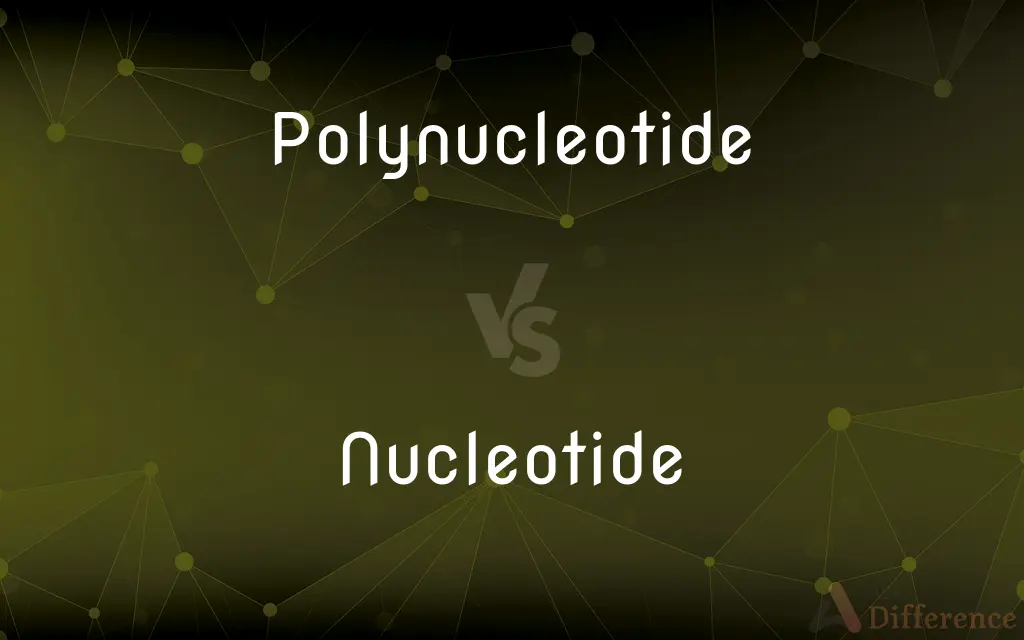Polynucleotide vs. Nucleotide — What's the Difference?
By Urooj Arif & Maham Liaqat — Updated on March 27, 2024
Polynucleotide is a chain of nucleotides, whereas a nucleotide is the basic building block of nucleic acids like DNA and RNA.

Difference Between Polynucleotide and Nucleotide
Table of Contents
ADVERTISEMENT
Key Differences
A polynucleotide refers to a long chain composed of many nucleotides linked together by covalent bonds. These chains form the backbone of DNA and RNA, carrying genetic information crucial for biological functions and heredity. A nucleotide, on the other hand, is a molecule made up of three components: a sugar (deoxyribose in DNA and ribose in RNA), a phosphate group, and a nitrogenous base (adenine, thymine, cytosine, guanine in DNA; adenine, uracil, cytosine, guanine in RNA). Nucleotides serve not only as the monomeric units of polynucleotides but also play essential roles in cellular energy transfer and metabolism.
While polynucleotides are integral to the structure and function of nucleic acids, individual nucleotides have broader functions within the cell, including participation in energy transfer as adenosine triphosphate (ATP) and in signaling pathways as cyclic adenosine monophosphate (cAMP). This dual role highlights the versatility and importance of nucleotides beyond their function in polynucleotides.
The formation of polynucleotides from nucleotides involves dehydration synthesis reactions, where the phosphate group of one nucleotide forms a covalent bond with the sugar of another, creating a sugar-phosphate backbone with nitrogenous bases as appendages. This process is fundamental to the replication and expression of genetic information.
While a polynucleotide is a macromolecule critical for storing and transmitting genetic information, nucleotides are versatile molecules that play several key roles in the cell, from serving as building blocks of nucleic acids to participating in energy metabolism and cell signaling.
Comparison Chart
Definition
A chain of nucleotides linked together.
The basic building block of DNA and RNA, consisting of a sugar, phosphate group, and base.
ADVERTISEMENT
Components
Multiple nucleotides
A sugar, phosphate group, and nitrogenous base
Function
Forms the structure of DNA and RNA, carrying genetic information.
Serves as a monomer of polynucleotides; involved in energy transfer and signaling.
Molecular Structure
Long chain structure
Monomer structure
Role in Genetics
Store and transmit genetic information.
Comprise the genetic code within polynucleotides.
Examples
DNA and RNA
ATP, cAMP, and the monomeric units of DNA and RNA
Compare with Definitions
Polynucleotide
The structure that forms the backbone of DNA and RNA.
The polynucleotide chain in RNA is single-stranded, allowing it to perform various functions in the cell.
Nucleotide
Nucleotides play a role in cell signaling pathways.
Guanosine triphosphate (GTP) nucleotides are involved in signal transduction.
Polynucleotide
A molecule that can carry genetic codes for synthesis of proteins.
Messenger RNA (mRNA) is a polynucleotide that conveys genetic messages from DNA to the ribosome.
Nucleotide
A molecule that can form the building blocks of DNA or RNA.
Cyclic AMP (cAMP) is a nucleotide that acts as a secondary messenger in hormone action.
Polynucleotide
Polynucleotides can act as templates for duplicating genetic information.
During cell division, DNA polynucleotides replicate to ensure genetic continuity.
Nucleotide
The basic structural unit of nucleic acids.
A nucleotide in DNA contains deoxyribose sugar, a phosphate group, and one of four nitrogenous bases.
Polynucleotide
They participate in vital biological processes, including transcription and translation.
Transfer RNA (tRNA) polynucleotides are crucial for the translation of mRNA into proteins.
Nucleotide
They can also function in enzyme reactions as coenzymes.
NAD+ (nicotinamide adenine dinucleotide) is a nucleotide that functions as a coenzyme in redox reactions.
Polynucleotide
A polymer consisting of many nucleotides covalently bonded to form a chain.
DNA is a polynucleotide that stores genetic information in cells.
Nucleotide
Involved in cellular energy transfer.
Adenosine triphosphate (ATP) is a nucleotide used by cells as a coenzyme for energy transfer.
Polynucleotide
A polynucleotide molecule is a biopolymer composed of 13 or more nucleotide monomers covalently bonded in a chain. DNA (deoxyribonucleic acid) and RNA (ribonucleic acid) are examples of polynucleotides with distinct biological function.
Nucleotide
Nucleotides are organic molecules consisting of a nucleoside and a phosphate. They serve as monomeric units of the nucleic acid polymers – deoxyribonucleic acid (DNA) and ribonucleic acid (RNA), both of which are essential biomolecules within all life-forms on Earth.
Polynucleotide
A linear polymer whose molecule is composed of many nucleotide units, constituting a section of a nucleic acid molecule.
Nucleotide
A compound consisting of a nucleoside linked to a phosphate group. Nucleotides form the basic structural unit of nucleic acids such as DNA.
Polynucleotide
A polymeric compound, usually DNA or RNA, consisting of a number of nucleotides.
Nucleotide
Any of a group of compounds consisting of a nucleoside combined with a phosphate group and constituting the units that make up DNA and RNA molecules.
Polynucleotide
(biochemistry) A polymeric macromolecule composed of many nucleotides; examples include DNA and RNA
Nucleotide
(biochemistry) The monomer constituting DNA or RNA biopolymer molecules. Each nucleotide consists of a nitrogenous heterocyclic base (or nucleobase), which can be either a double-ringed purine or a single-ringed pyrimidine; a five-carbon pentose sugar (deoxyribose in DNA or ribose in RNA); and a phosphate group.
Nucleotide
A phosphate ester of a nucleoside; one of the monomeric components of DNA or RNA.
Nucleotide
A phosphoric ester of a nucleoside; the basic structural unit of nucleic acids (DNA or RNA)
Common Curiosities
What distinguishes a polynucleotide from a nucleotide?
A polynucleotide is a chain of many nucleotides linked together, forming the structure of DNA and RNA, while a nucleotide is a single building block of these polynucleotides.
How are polynucleotides formed from nucleotides?
Polynucleotides are formed through dehydration synthesis reactions, where nucleotides are joined by covalent bonds between their phosphate group and sugar.
How do nucleotides and polynucleotides interact in cellular activities?
Nucleotides serve as the monomeric units for building polynucleotides and also participate in essential cellular activities like energy metabolism and signaling.
What roles do polynucleotides play in genetics?
Polynucleotides store and transmit genetic information through the processes of replication, transcription, and translation.
Can nucleotides function independently of polynucleotides?
Yes, nucleotides can function independently in various cellular processes, such as energy transfer (ATP) and signaling (cAMP).
Are all nucleotides part of polynucleotides?
Not all nucleotides are part of polynucleotides; some function in other cellular roles, such as ATP in energy transfer and cAMP in signaling.
What makes nucleotides essential for life?
Nucleotides are essential for life because they are the building blocks of genetic material and play critical roles in energy transfer, cell signaling, and metabolism.
Do nucleotides have a role in diseases?
Yes, abnormalities in nucleotide metabolism can lead to diseases, and nucleotides are also targets for therapeutic drugs.
How do polynucleotides and nucleotides contribute to evolutionary processes?
Polynucleotides store genetic information that is subject to mutation and natural selection, driving evolutionary change, while nucleotide variability contributes to genetic diversity.
Can polynucleotides be synthetic?
Yes, polynucleotides can be synthetically produced, which is a common practice in genetic engineering and biotechnology research.
Share Your Discovery

Previous Comparison
Rideable vs. Ridable
Next Comparison
Bundle vs. BaleAuthor Spotlight
Written by
Urooj ArifUrooj is a skilled content writer at Ask Difference, known for her exceptional ability to simplify complex topics into engaging and informative content. With a passion for research and a flair for clear, concise writing, she consistently delivers articles that resonate with our diverse audience.
Co-written by
Maham Liaqat













































